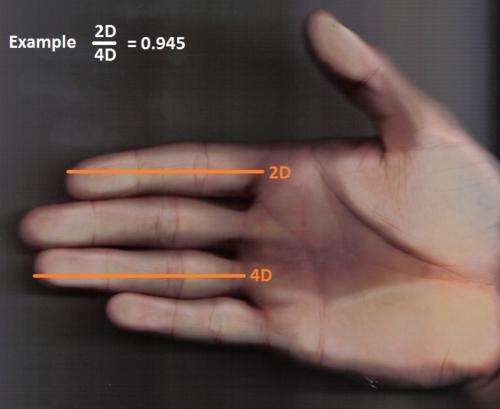Can science finger a philanderer?

Are people naturally monogamous, polygamous or promiscuous? It's one of those questions that most people feel quite confident in answering. Ask a few people and you're likely to receive a variety of contradictory answers, each delivered with considerable confidence. But the question is far more slippery than it first appears.
I will return later to the question of humanity's "natural" mating system, but lately I've been far more interested in why people hold such strong opinions on the subject. And I think it's mostly out of keenness to understand ourselves and those we love, to navigate the perilous tension between monogamy and non-monogamy that runs through our own lives. And, often, to validate our own proclivities.
With the Hallmark Holiday of St Valentine's Day just a few days away, a recent study that touches on the monogamy-promiscuity tension deserves close examination. Particularly because various media outlets made it sound like a litmus test of whether someone is a likely 'strayer' or a certain 'stayer'.
Sociosexuality
In 'Stay or Stray: evidence for alternative mating strategy phenotypes in both men and women', Rafael Wodarski, John Manning and Robin Dunbar probe the statistical distributions of two traits related to sexual behaviour. They ask whether sociosexuality and the relative lengths of the second and forth fingers (2D:4D ratio) conform to distributions with one peak or two. A bimodal distribution, with two peaks, suggests there may be two different groups of individuals within a given sample.
An individual's sociosexuality reflects how restricted their attitudes toward sex and their sexual behaviours are. Wlodarski's team used answers from the following six questions in the 9-item Revised Sociosexual Orientation Inventory (SOI):
- With how many different partners have you had sex within the past 12 months?
- With how many different partners have you had sexual intercourse on one and only one occasion?
- With how many different partners have you had sexual intercourse without having an interest in a long-term committed relationship with this person?
- Sex without love is OK. (this and the next two questions answered on a scale from strongly disagree to strongly agree)
- I can imagine myself being comfortable and enjoying "casual" sex with different partners.
- I do not want to have sex with a person until I am sure that we will have a long-term, serious relationship.
High scores (plenty of agreeing, and lots of casual sex) characterise an unrestricted sociosexuality, whereas people with restricted sociosexuality tend to get low scores.
The statistical tests showed that within fairly large samples of British and American subjects, there was evidence that both women's and men's SOI scores are distributed bimodally. But there's plenty of overlap between the peaks (modes). The authors infer that within each sex exists a more restricted, monogamous group of individuals and another group of unrestricted promiscuous people.
Here, and in almost every study using SOI, men tend to have more unrestricted sociosexuality than women, on average. The difference in means could be pinned on small differences in the percentages of men and women in the restricted and unrestricted SOI groups.
Digit ratios
The group also analysed a sample of hand measurements of 1314 British subjects. They looked at the ratio of the index finger (second digit, or 2D) to the ring finger (4D). Adults who were exposed to higher levels of testosterone when they were in the womb, tend to have relatively short index fingers (small 2D:4D ratio).
Now that you've stopped looking at your fingers, can we move along?

Prenatal testosterone exposure is also thought to bias individuals toward more promiscuous sexuality when they reach adulthood. The pattern also works across species: monkey and ape species with long-term pair bonds and a knack for monogamy tend to have high 2D:4D ratios.
Interestingly, when Wlodarski's team applied their statistical tests to the distribution of 2D:4D ratios, they again found evidence of bimodality. A similar pattern in two very different traits associated with promiscuity-monogamy suggested to them a provocative conclusion:
Perhaps we are dealing here with two different types of people.
What if some folks are good at monogamy whereas others are rather better at … the other stuff? Perhaps. Funny thing about sex research is that any conclusion you arrive at will leave some people feeling validated and an almost equal number something more like violated.
We go on foot from here
But the idea is worth exploring. The valuable thing about this study is that it challenges our too-common tendency to see every trait as a continuum, with a few individuals at either end and the majority somewhere in the middle.
Interestingly, the two measures, SOI and 2D:4D ratio were from different samples. At no point did the researchers provide any evidence that the two groups separated on digit ratio were the same individuals as those separated on SOI. They couldn't be: they were different samples.
The links between SOI and 2D:4D ratios are, at best, equivocal. Some studies find that low 2D:4D is associated with higher SOI. Other studies fail to find such effects. And a study of women and men from Brazil and from the Czech Republic, found that in both sexes a more feminine (higher) 2D:4D ratio is associated with less restricted sociosexuality.
But you wouldn't know it from the media coverage. The Daily Mirror over-promised, trumpeting that "Boffins" have learned "How to work out if your partner is cheating on you? Check their fingers". Well, checking if they've been hiding their wedding ring might tell you something, but checking out their 2D:4D ratio won't help at all.
Nonetheless, Valentine's Day dinners are going to involve a lot of quizzical staring at fingers this year. (And not out of daydreaming that he might just put a ring on it.)
The UK's Telegraph took a more introspective line under the headline "Are you promiscuous or faithful? Measure your index finger to find out".
Actually, a better way to figure out if you are promiscuous or faithful, or if you are likely to be in the future, is to ask yourself the questions in the Sociosexual Inventory. It's pretty straightforward: if you've had plenty of one-off sex and lots of partners in the last year, then odds are that you bend toward promiscuity. At least at this point in your life. But I can imagine folks on both side of the 2D:4D distribution reassuring themselves that they are doing the right thing.
Sometimes I wonder why scientists even bother talking to the media. The public love to learn the latest things that "boffins have figured out", but they deserve journalism that makes at least a token effort to grapple with the research or speak to said boffins.
What are we?
The distribution of SOI and 2D:4D cannot tell us all that much about humanity as a whole, other than that both women and men vary in their openness to casual sex and their proportional finger length.
But this variation is part of what makes human sexual behaviour so fascinating. Some people do seem at ease with life-long monogamy whereas others are shockingly bad at it.
How that variation arises presents a very interesting bevy of questions. Cue the usual intellectually bereft wrangling over nature and nurture as though the two were alternatives.
I'm sure there is more than one reason, but an obvious candidate for variation in sociosexuality is religion. Perhaps those who buy in to religious practices are more likely to be on the "restricted" end of the sociosexuality distribution, whereas those who have rejected or never embraced religion are more likely to be in the "unrestricted" peak?
For now, my preferred answer to the question "Are people naturally monogamous, polygamous or promiscuous?" is "YES".
We have evolved adaptations that make some of us rather good at monogamy, some of the time. Until we're not. We also have an evolved capacity to leave one partner for another, or to partner up with more than one person at a time, depending on our circumstances.
If you're looking for natural history to vindicate your own particular preferred way of life over the alternatives, then you're always going to be disappointed.
This story is published courtesy of The Conversation (under Creative Commons-Attribution/No derivatives).
![]()















